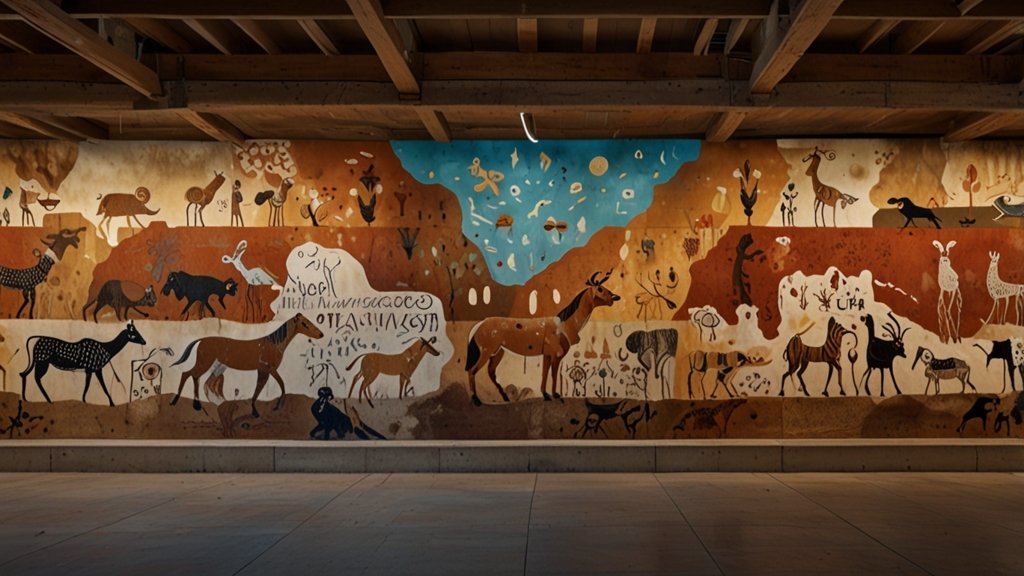Picture this: You’re standing in a dimly lit chamber, your torch flickering across walls adorned with ochre-bison and handprints left by someone 30,000 years ago. This isn’t a scene from a fantasy novel—it’s the Chauvet Cave in France, one of humanity’s oldest galleries. Ancient Artz isn’t just about relics gathering dust in museums; it’s a visceral bridge to our ancestors’ dreams, fears, and triumphs.
But why does this matter today? Because every brushstroke, chisel mark, and mosaic tile whispers stories of innovation, identity, and cross-cultural exchange long before hashtags or globalization. Let’s explore these narratives together.
The Birth of Creativity: From Caves to Civilizations
Prehistoric Art: The First Emojis
Before alphabets, humans communicated through symbols. The Lascaux Cave’s “Hall of Bulls” (15,000 BCE) isn’t just art—it’s a survival guide. Scholars argue these paintings were rituals for successful hunts, blending spirituality with practicality.
Key Innovations:
- Pigments: Charcoal, iron oxide, and animal fat mixed for durability.
- Storytelling: Scenes of herds and hunters reveal early narrative structures.
Mesopotamia: Where Gods and Kings Collide
The cradle of civilization gave us the Standard of Ur (2500 BCE), a wooden box depicting war and peace in lapis lazuli and shell. Unlike cave art, Mesopotamian works served political agendas—glorifying rulers like Gilgamesh and legitimizing divine authority.
Compare & Contrast: Mesopotamian vs. Egyptian Art
| Aspect | Mesopotamia | Egypt |
|---|---|---|
| Purpose | Propaganda for mortal kings | Eternal afterlife rituals |
| Materials | Mud brick, glazed tiles | Limestone, gold, papyrus |
| Symbolism | Winged bulls (lamassu) as protectors | Ankh (life), Eye of Horus (protection) |
The Aesthetic Revolution: Greece and Rome
Greek Sculpture: Perfection in Marble
The Discobolus (450 BCE) isn’t just a statue of an athlete—it’s a study of geometry and human potential. Greeks pioneered contrapposto (weight shift), making stone seem alive.
Did You Know?
- Roman copies saved Greek originals from oblivion.
- The Parthenon Marbles (now in the British Museum) sparked debates on cultural ownership—ancient drama meets modern politics.
Roman Engineering Meets Art
Romans borrowed Greek aesthetics but added pragmatism. The Pantheon’s dome (126 CE)—still the world’s largest unreinforced concrete dome—showcases their fusion of art and engineering.
Innovation Spotlight:
- Mosaics: Tiny tesserae tiles depicted myths and daily life.
- Frescoes: Pompeii’s villas preserved vibrant scenes of feasts and flora.
The Silent Traders: Cross-Cultural Influences
Ancient Artz was never created in a vacuum. The Silk Road ferried motifs from China to Rome:
- Hellenistic Buddhas: Greek sculptors in Afghanistan gave Buddha human-like features.
- Egyptian Blue: This pigment reached Pompeii via Mediterranean trade.
Why Ancient Artz Matters Today
Lessons for Modern Creators
- Sustainability: Inca architects built earthquake-resistant structures without mortar.
- Storytelling: Maya glyphs merge image and text—a precursor to graphic novels.
3 Ways to Engage with Ancient Artz
- Visit Virtual Museums: The Louvre’s online tours let you zoom into Sumerian tablets.
- DIY Pigments: Grind ochre or charcoal to create your own cave-style paint.
- Support Repatriation: Learn about efforts to return artifacts to their homelands.
You May Also Read: Success100x: The Proven Framework for Exponential Growth in Work and Life
Conclusion
Ancient Artz isn’t locked in the past. It’s in the curve of a smartphone (inspired by Greek amphoras) and the murals adorning city streets. So the next time you pick up a coffee mug, remember: you’re holding the descendant of Mesopotamian pottery.
Call to Action: Share your favorite ancient artwork on social media with #AncientArtzRevival. Let’s make history trend!
FAQs
Why study Ancient Artz if it’s thousands of years old?
These works reveal universal human themes—love, power, mortality—that still resonate. Plus, they’re blueprints for innovation (e.g., Roman concrete inspires eco-friendly materials).
How did ancient artists make paints without modern tools?
They used organic materials: crushed minerals, plants, and even insects (cochineal for red).
What’s the oldest known artwork?
The Sulawesi Cave paintings (Indonesia, 45,500 years old) depict wild pigs in red ochre.
Did ancient civilizations critique each other’s art?
Yes! Roman poet Horace mocked overly ornate Greek statues, proving snarky art critics aren’t a modern invention.
How does Ancient Artz relate to religion?
Most works were devotional—Egyptian tomb art guided souls to the afterlife, while Hindu temple carvings illustrated sacred myths.
Can I see Ancient Artz influences in pop culture?
Absolutely. Black Panther’s costumes drew on African tribal art, and Assassin’s Creed games recreate ancient cities with archeological accuracy.
What’s the biggest mystery in Ancient Artz?
The purpose of Britain’s Stonehenge—was it a calendar, healing site, or alien landing pad? (We’re leaning toward the first two.)










